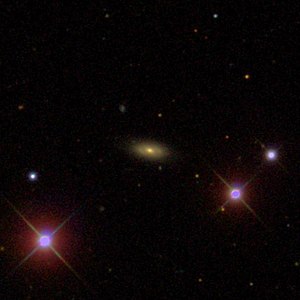NGC 5502
| Galaxy NGC 5502 / NGC 5503 |
|
|---|---|

|
|
| SDSS recording | |
| AladinLite | |
| Constellation | Big Bear |
|
Position equinox : J2000.0 , epoch : J2000.0 |
|
| Right ascension | 14 h 09 m 33.9 s |
| declination | + 60 ° 24 ′ 35 ″ |
| Appearance | |
| Morphological type | Sa: |
| Brightness (visual) | 15.3 mag |
| Brightness (B-band) | 16.1 mag |
| Angular expansion | 0.3 ′ × 0.1 ′ |
| Position angle | 87 ° |
| Surface brightness | 11.3 mag / arcmin² |
| Physical data | |
| Redshift | 0.029456 +/- 0.000161 |
| Radial velocity | 8831 +/- 48 km / s |
|
Stroke distance v rad / H 0 |
(401 ± 28) · 10 6 ly (122.8 ± 8.6) Mpc |
| history | |
| discovery | Edward Swift |
| Discovery date | May 9, 1885 |
| Catalog names | |
| NGC 5502, 5503 • PGC 50508 • MCG + 10-20-077 • 2MASX J14093397 + 6024346 • 2MASS J14093396 + 6024342 | |
NGC 5502 = NGC 5503 is a 15.3 mag bright spiral galaxy of the Hubble type Sa in the constellation Great Bear in the northern sky . It is estimated to be 401 million light years from the Milky Way and about 35,000 light years in diameter.
The object was discovered on May 9, 1885 by Edward D. Swift (described as "between two stars, one a wide double" and listed as NGC 5502 ), the observation of his father Lewis A. Swift two days later led with the description " forms with two stars a right triangle ”under NGC 5503 for the second entry in the catalog.
